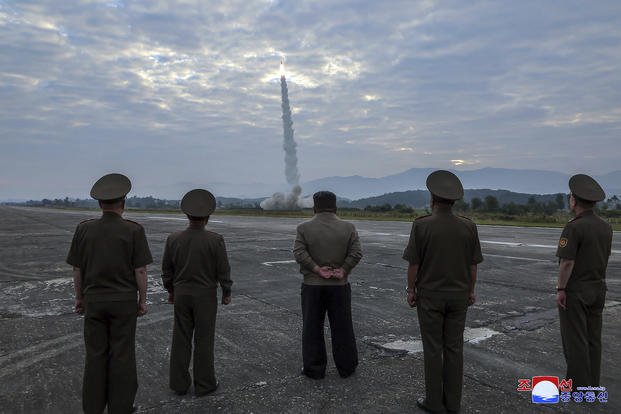SEOUL, South Korea — North Korea said Thursday that leader Kim Jong Un supervised successful tests of two types of missiles — one designed to carry a “super-large conventional warhead” and the other likely for a nuclear warhead, as he ordered officials to bolster up his country’s military capabilities to repel United States-led threats.
The tests appear to be the same as the multiple missile launches that neighboring countries said North Korea performed Wednesday, extending its run of weapons displays as confrontations with the U.S. and South Korea escalate.
The official Korean Central News Agency said that Kim oversaw the launch of the country’s newly built Hwasongpho-11-Da-4.5 ballistic missile tipped with a dummy “4.5-ton super-large conventional warhead.” It said the test-firing was meant to verify an ability to accurately hit a 320 kilometer (200 mile) -range target, suggesting it’s a weapon aimed at striking sites in South Korea.
KCNA said Kim also guided the launch of an improved “strategic” cruise missile, a word implying the weapon was developed to carry a nuclear warhead.
After the tests, Kim stressed the need to continue to “bolster up the nuclear force” and acquire “overwhelming offensive capability in the field of conventional weapons, too,” according to KCNA. It cited the Kim as saying that North Korea can thwart its enemies’ intentions to invade only when it has strong military power.
KCNA released photos of a missile hitting a ground target. South Korea’s military said later Thursday it assessed that both ballistic and cruise missiles fired by North Korea the previous day landed in the North’s mountainous northeastern region.
North Korea typically test-launches missiles off its east coast, and it’s highly unusual for the country to fire missiles at land targets likely because of concerns about potential damages on the ground if the weapons land in unintended areas.
Jung Chang Wook, head of the Korea Defense Study Forum think tank in Seoul, said North Korea likely aims to show it’s confident about the the accuracy of its new ballistic missile. Jung said the missile’s high-powered warhead is meant to attack ground targets, but North Korea hasn’t acquired weapons that can penetrate deep into the earth and destroy underground structures.
The Hwasongpho-11-Da-4.5 missile’s first known test occurred in early July. North Korea said the July test was successful as well, but South Korea’s military disputed the claim saying one of the two missiles fired by North Korea travelled abnormally during the initial stage of its flight before falling at an uninhabited area near Pyongyang, the capital. North Korea hasn’t released photos on the July launches.
North Korea has been pushing to introduce a variety of sophisticated weapons systems designed to attack both South Korea and the mainland U.S. to deal with what it calls its rivals’ intensifying security threats. Many foreign experts say North Korea would ultimately want to use its enlarged arsenal as leverage to win greater concessions in future dealings with the U.S.
Worries about North Korea deepened last week as it disclosed photos of a secretive facility to enrich uranium for nuclear weapons. KCNA said that Kim, during a visit to the facility, called for stronger efforts to “exponentially” produce more nuclear weapons.
It was unclear whether the facility is at North Korea’s main Yongbyon nuclear complex. But it was the North’s first unveiling of a uranium-enrichment facility since it showed one at the country’s main Yongbyon nuclear complex to visiting American scholars led by nuclear physicist Siegfried Hecker in 2010.
In an analytical piece jointly written with another expert, Robert Carlin, that was posted Wednesday on North Korea-focused website 38 North, Hecker said the centrifuge hall shown in the recent North Korean photos was not the same one that he saw in November 2010.
Hecker and Carlin said they believe the new centrifuges provide “only a modest increased capacity,” though North Korea could increase enrichment capacity just by building more centrifuge plants.
In another joint analysis also posted Friday on 38 North, other experts said that the centrifuges shown in the photos are not the ones observed by Hecker but a more advanced design. They said the images send “a strong message that the country has ample capacity and continued will to expand its nuclear program.”
Story Continues
© Copyright 2024 Associated Press. All rights reserved. This material may not be published, broadcast, rewritten or redistributed.
Read the full article here

